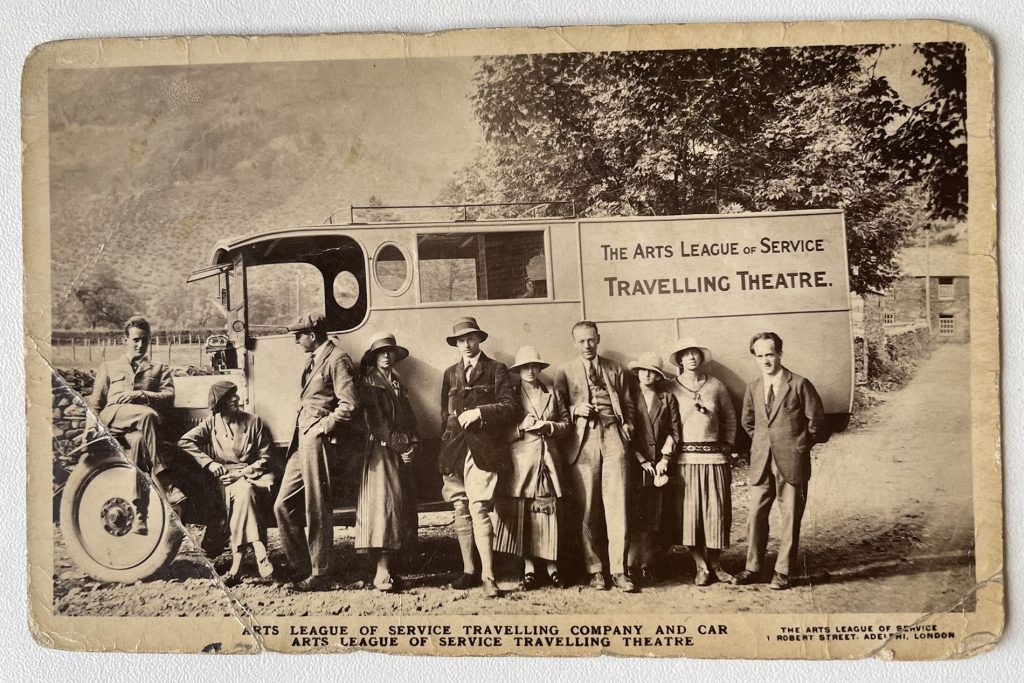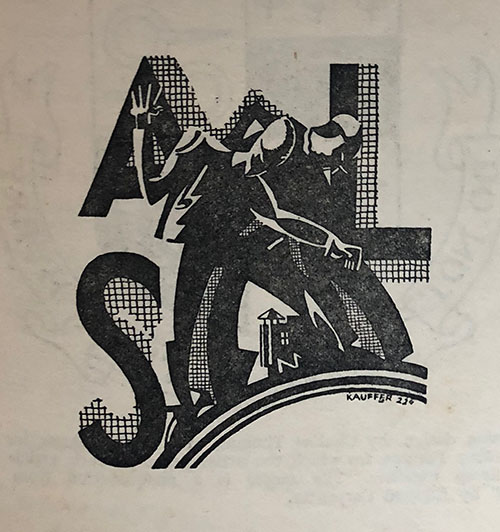OTD in early British television: 18 January 1937

John Wyver writes: at 3.01pm and again at 9.01pm on Monday 18 January 1937, via the Marconi-EMI system, Alexandra Palace transmitted a 15-minute programme of folk songs and sea shanties by the Arts League of Service (ALS). Bunny Churcher, John Rudling, Dennis Hutchinson, Eleanor Elder, and Brandon Acton-Bond performed songs including ‘Polly Oliver’ (arranged by Cecil Sharp) and ‘The Moorish Maid’, while Rosemary Jephson demonstrated Margaret Morris movement exercises to Schubert. And the ALS…?
An absolutely fascinating blog created by Emma West, Revolutionary Red Tape (from where I’ve appropriated ther postcard above), offers this snapshot of the ALS:
Formed in the wake of the First World War, the ALS aimed to ‘bring the Arts into Everyday Life’. They sought to improve the lives both of rural communities, especially men returning from active service, and artists struggling with soaring rents, unemployment and economic depression. The organisation was split into two sections: the Drama Section, headed by dance teacher Eleanor Elder, and the Arts Section, headed by South American art enthusiast Ana M. Berry.
The ALS Travelling Theatre, headed by Elder, gave thousands of performances of one-act plays, ballets, mimes and songs in village halls across the UK and Ireland… the Travelling Theatre continued until 1937, when financial difficulties and competition from local theatrical groups caused its demise. For more on the Arts Section of the ALS, see Martin Hopkinson’s article ‘The Arts League of Service in London 1919-1928’, Print Quarterly 30:2 (2013).

Elder, as you will have noticed, was one of the performers at AP in January 1937, and clearly this single television performance must have come towards the end of the ALS Travelling Theatre’s activities. The image above is Edward McKnight Kauffer’s ALS Logo, created in 1922 and featured in ALS Bulletin in 1932.
Revolutionary Red Tape, which started in 2019 based at the University of Birmingham, is ‘a five-year research project funded by the British Academy… [which] explores how pioneering public servants, artists and administrators worked to increase public access to the arts in modern Britain.’
Elsewhere on the blog, Emma West writes passionately about Eleanor Elder, including a connection via Frank Benson with another subject that fascinates me, the early history of the Shakespeare Memorial Theatre in Stratford-upon-Avon, where Benson’s company played annual seasons:
Actor, dancer, producer, founder and manager of the Arts League of Service Travelling Theatre, Eleanor Elder was something of a polymath. From an early age, she had a passion for the stage, training with F. R. Benson’s Shakespearean Company, before joining Margaret Morris’s dance troupe as a pupil and later as a teacher at her dance school. But she missed the stage, and returned to acting in the Shakespearean Company before the outbreak of war took her to India…
On her return to Britain in the autumn of 1918, with encouragement from Margaret Morris (whose dance troupe also appeared on the early television service, of which more anon), Elder set up the ALS.
Alongside fellow actress, producer, manager and Honorary Secretary Judith Wogan and secretary Veronica Wynne, Elder worked tirelessly to keep the Travelling Theatre afloat. Despite occasional grants from the Carnegie United Kingdom Trust, the ALS constantly struggled for money. The infrequent ALS Bulletins often featured pleas for donations. Before the financial crash, tours made a profit, but after 1930 the economic depression meant that all subsequent tours incurred a loss. The company disbanded in 1937.
The website is packed with interesting posts and pictures like this, including a link to Emma West’s article [behind the journal’s subscription paywall] ‘“within the reach of all”: bringing art to the people in interwar Britain’ in Modernist Cultures 15:2 (2020), for which this is the abstract:
The years during and after the Great War saw an explosion in arts organisations attempting ‘to bring the Arts into everyday life’. This essay argues that arts organisations should be seen alongside institutions like bookshops, magazines and galleries as key mediating institutions between modernist artists and writers and the general public. Using the Arts League of Service as a case study, I explore whether it was possible for such organisations to be experimental, educational and popular. To what extent could they reconcile their democratic principles with their belief in the transformative power of experimental modern art, design, literature and performance?
The brief – and only – appearance of the ALS on the Television service from AP, at a moment when the number of receivers was almost certainly just a few hundred, is a poignant footnote to the organisation’s visionary activities.
Leave a Reply